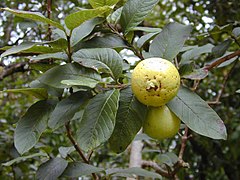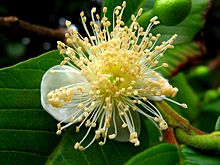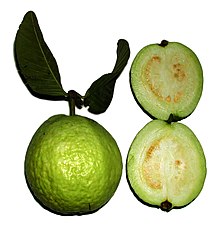Guava: Difference between revisions
m Reverted 1 edit by 113.210.255.249 (talk) identified as vandalism to last revision by FoxBot. (TW) |
No edit summary |
||
| Line 40: | Line 40: | ||
Outside of Europe, the [[Arabic (language)|Arabic]] ''jwafa'', the [[Japanese (language)|Japanese]] ''guaba'' (グアバ), the [[Tamil (language)|Tamil]] "koiyaa" (கொய்யா), the [[Tongan (language)|Tongan]] ''kuava'' and probably also the [[Tagalog language|Tagalog]] ''bayabas'' are ultimately derived from the Arawak term. |
Outside of Europe, the [[Arabic (language)|Arabic]] ''jwafa'', the [[Japanese (language)|Japanese]] ''guaba'' (グアバ), the [[Tamil (language)|Tamil]] "koiyaa" (கொய்யா), the [[Tongan (language)|Tongan]] ''kuava'' and probably also the [[Tagalog language|Tagalog]] ''bayabas'' are ultimately derived from the Arawak term. |
||
Another term for guavas is ''pera'' or variants thereof. It is common around the western [[Indian Ocean]] and probably derives from Spanish or Portuguese, which means "pear", or from some language of southern [[India]], though it is so widespread in the region that its origin cannot be clearly discerned any more. ''Pera'' itself is used in [[Malayalam]], [[Sinhala (language)|Sinhala]] and [[Swahili language|Swahili]]. In [[Marathi (language)|Marathi]] it is ''peru'', in [[Bengali (language)|Bengali]] ''pearah'' (পেয়ারা), in Kannada it is ''pearaley'' ('ಪೇರಲೆ') or ''seebe kaayi'' ('ಸೀಬೇಕಾಯಿ ') and in [[Dhivehi language|Dhivehi]] ''feyru''. In Telugu language it is "Jama kaya". |
Another term for guavas is ''pera'' or variants thereof. It is common around the western [[Indian Ocean]] and probably derives from Spanish or Portuguese, which means "pear", or from some language of southern [[India]], though it is so widespread in the region that its origin cannot be clearly discerned any more. ''Pera'' itself is used in [[Malayalam]], [[Sinhala (language)|Sinhala]] and [[Swahili language|Swahili]]. In [[Marathi (language)|Marathi]] it is ''peru'' (पेरू), in [[Bengali (language)|Bengali]] ''pearah'' (পেয়ারা), in Kannada it is ''pearaley'' ('ಪೇರಲೆ') or ''seebe kaayi'' ('ಸೀಬೇಕಾಯಿ ') and in [[Dhivehi language|Dhivehi]] ''feyru''. In Telugu language it is "Jama kaya". |
||
Additional terms for guavas from their native range are, for example, ''sawintu'' ([[Quechua languages|Quechua]]) and ''xālxocotl'' ([[Nāhuatl]]) |
Additional terms for guavas from their native range are, for example, ''sawintu'' ([[Quechua languages|Quechua]]) and ''xālxocotl'' ([[Nāhuatl]]) |
||
Revision as of 18:09, 21 July 2011
This article includes a list of general references, but it lacks sufficient corresponding inline citations. (August 2010) |
| Guavas | |
|---|---|

| |
| Apple Guava (Psidium guajava) | |
| Scientific classification | |
| Kingdom: | |
| Division: | |
| Class: | |
| Subclass: | |
| Order: | |
| Family: | |
| Subfamily: | |
| Tribe: | |
| Genus: | Psidium |
| Species | |
|
About 100, see text | |
| Synonyms | |
|
Calyptropsidium O.Berg | |
Guavas are plants in the myrtle family (Myrtaceae) genus Psidium (meaning "pomegranate" in Latin),[2] which contains about 100 species of tropical shrubs and small trees. They are native to Mexico, Central America, and northern South America. Guavas are now cultivated and naturalized throughout the tropics and subtropics in Southeast Asia, Hawaii, the Caribbean, Florida and Africa.
Types
The most frequently encountered species, and the one often simply referred to as "the guava", is the Apple Guava (Psidium guajava).[citation needed]
Guavas are typical Myrtoideae, with tough dark leaves that are opposite, simple, elliptic to ovate and 5–15 cm long. The flowers are white, with five petals and numerous stamens.
The genera Accara and Feijoa (= Acca, Pineapple Guava) were formerly included in Psidium.
Common names

The term "guava" appears to derive from Arawak guayabo "guava tree", via the Spanish guayaba. It has been adapted in many European languages: guava (Romanian, Swedish, Danish and Norwegian, also Greek Γκουάβα and Russian Гуава), Guave (Dutch and German), goyave (French), gujawa (Polish), goiaba (Portuguese).
Outside of Europe, the Arabic jwafa, the Japanese guaba (グアバ), the Tamil "koiyaa" (கொய்யா), the Tongan kuava and probably also the Tagalog bayabas are ultimately derived from the Arawak term.
Another term for guavas is pera or variants thereof. It is common around the western Indian Ocean and probably derives from Spanish or Portuguese, which means "pear", or from some language of southern India, though it is so widespread in the region that its origin cannot be clearly discerned any more. Pera itself is used in Malayalam, Sinhala and Swahili. In Marathi it is peru (पेरू), in Bengali pearah (পেয়ারা), in Kannada it is pearaley ('ಪೇರಲೆ') or seebe kaayi ('ಸೀಬೇಕಾಯಿ ') and in Dhivehi feyru. In Telugu language it is "Jama kaya".
Additional terms for guavas from their native range are, for example, sawintu (Quechua) and xālxocotl (Nāhuatl)
Ecology and uses

Psidium species are used as food plants by the caterpillars of some Lepidoptera, mainly moths like the Ello Sphinx (Erinnyis ello), Eupseudosoma aberrans, E. involutum, and Hypercompe icasia. Mites like Pronematus pruni and Tydeus munsteri are known to parasitize the Apple Guava (P. guajava) and perhaps other species. The bacterium Erwinia psidii causes rot diseases of the Apple Guava.
The fruit are not only relished by humans, but by many mammals and birds as well. The spread of introduced guavas owes much to this fact, as animals will eat the fruit and disperse the seeds in their droppings.
In several tropical regions, including Hawaii, some species (namely Strawberry Guava, P. littorale, and to a lesser extent Apple Guava Psidium guajava) have become invasive species. On the other hand, several species have become very rare due to habitat destruction and at least one (Jamaican Guava, P. dumetorum), is already extinct.
Guava wood is used for meat smoking in Hawaii and is being used at barbecue competitions across the United States. In Cuba the leaves are also used in barbecues, providing a smoked flavor and scent to the meat.

Cultivation for fruit
Guavas are cultivated in many tropical and subtropical countries for their edible fruit. Several species are grown commercially; apple guava (P. guajava) and its cultivars are those most commonly traded internationally.

Mature trees of most species are fairly cold-hardy and can survive as low as 5 °C (41 °F) for short periods of time, but younger plants will not survive. They are known to survive in Northern Pakistan where they can get down to 5°C or lower during the night. A few species - notably strawberry guavas - can survive temperatures several degrees below freezing for short periods of time.

Guavas are also of interest to home growers in temperate areas, being one of the few tropical fruits that can grow to fruiting size in pots indoors. When grown from seed, guavas can bloom and bear fruit as soon as two years, or as long as eight years.
Guava fruit
Guava fruit, usually 4 to 12 cm long, are round or oval depending on the species. The outer skin may be rough, often with a bitter taste, or soft and sweet. Varying between species, the skin can be any thickness, is usually green before maturity, but becomes yellow, maroon, or green when ripe.
Guava fruit generally have a pronounced and typical fragrance, similar to lemon rind but less sharp. Guava pulp may be sweet or sour, off-white ("white" guavas) to deep pink ("red" guavas), with the seeds in the central pulp of variable number and hardness, depending on species.

Culinary uses
In Hawaii, guava fruit is eaten with soy sauce and vinegar. Occasionally, a pinch of sugar and black pepper are added to the soy sauce and vinegar mixture. The guava fruit is cut up and dipped into the sauce.
In Pakistan and India, guava fruit is often eaten raw, typically cut into quarters with a pinch of salt and pepper and sometimes cayenne powder/masala. Street vendors often sell guava fruit for a couple of rupees each.
The fruit is also often prepared as a dessert, in fruit salads. In Asia, fresh guava slices are often dipped in preserved prune powder or salt. In India it is often sprinkled with red rock salt, which is very tart.
Because of the high level of pectin, guavas are extensively used to make candies, preserves, jellies, jams, marmalades (Brazilian goiabada), and also for juices and aguas frescas.
Guava juice is very popular in Hawaii, Cuba, Puerto Rico, Colombia, Venezuela, Egypt, Mexico, and South Africa.
"Red" guavas can be used as the base of salted products such as sauces, substituting for tomatoes, especially for those sensitive to the latter's acidity. In Asia, a drink is made from an infusion of guava fruits and leaves. In Brazil, the infusion made with guava tree leaves (chá-de-goiabeira, i.e. "tea" of guava tree leaves) is considered medicinal.

Nutritional value
Guavas are often included among superfruits, being rich in dietary fiber, vitamins A and C, folic acid, and the dietary minerals, potassium, copper and manganese. Having a generally broad, low-calorie profile of essential nutrients, a single common guava (P. guajava) fruit contains about four times the amount of vitamin C as an orange.[3]
However, nutrient content varies across guava cultivars. Although the strawberry guava (P. littorale var. cattleianum), notably containing 90 mg of vitamin C per serving, has about 25% of the amount found in more common varieties, its total vitamin C content in one serving still provides 100% of the Dietary Reference Intake for adult males.[4]

Guavas contain both carotenoids and polyphenols like (+)-gallocatechin,[5] guaijaverin, leucocyanidin and amritoside[6] – the major classes of antioxidant pigments – giving them relatively high potential antioxidant value among plant foods.[7] As these pigments produce the fruit skin and flesh color, guavas that are red-orange have more pigment content as polyphenol, carotenoid and pro-vitamin A, retinoid sources than yellow-green ones.[8]

| Common Guava, per 165 g of individual fruit portion | |
|---|---|
| Calories | 112 |
| Moisture | 133 g |
| Dietary Fiber | 8.9 g (36%) |
| Protein | 4.2 g (8%) |
| Fat | 1.6 g (2%) |
| Ash | 2.3 g |
| Carbohydrates | 23.6 g (8%) |
| Calcium | 30 mg (3%) |
| Phosphorus | 66 mg (7%) |
| Iron | 0.4 mg (2%) |
| Potassium | 688 mg (20%) |
| Copper | 0.4 mg (19%) |
| Beta-carotene (Vitamin A) | 1030 IU (21%) |
| Ascorbic acid (Vitamin C) | 377 mg (628%) |
| Thiamin (Vitamin B1) | 0.1 mg (7%) |
| Riboflavin (Vitamin B2) | 0.1 mg (4%) |
| Niacin (Vitamin B3) | 1.8 mg (9%) |
| Folic acid | 81 mcg (20%) |
% Daily Value in parentheses. Nutrient data source: US Department of Agriculture National Nutrient Database from Nutritiondata.com
Potential medical uses
Since the 1950s, guavas – particularly the leaves – have been a subject for diverse research in chemical identity of their constituents, pharmacological properties and history in folk medicine.[9] Most research, however, has been conducted on apple guava (P. guajava), with other species remaining undefined. From preliminary medical research in laboratory models, extracts from apple guava leaves or bark are implicated in therapeutic mechanisms against cancer, bacterial infections, inflammation and pain.[10] Essential oils from guava leaves display anti-cancer activity in vitro.[11]
Guava leaves are used in folk medicine as a remedy for diarrhea[12] and, as well as the bark, for their supposed antimicrobial properties and as an astringent. Guava leaves or bark are used in traditional treatments against diabetes.[13] In Trinidad, a tea made from young leaves is used for diarrhea, dysentery and fever.[14]
Selected species


|
|
Formerly placed here
- Acca macrostema (Ruiz & Pav. ex G.Don) McVaugh (as P. macrostemum Ruiz & Pav. ex G.Don)
- Campomanesia adamantium (Cambess.) O.Berg (as P. adamantium Cambess.)
- Campomanesia aromatica (Aubl.) Griseb. (as P. aromatica Aubl.)
- Campomanesia grandiflora (Aubl.) Sagot (as P. grandiflorum Aubl.)
- Campomanesia guaviroba (DC.) Kiaersk. (as P. cerasoides Cambess. or P. guaviroba DC.)
- Campomanesia lineatifolia Ruiz & Pav. (as P. rivulare DC.)
- Campomanesia pubescens (Mart. ex DC.) O.Berg (as P. corymbosum Cambess., P. obversum Miq. or P. pubescens Mart. ex DC.)
- Eugenia salamensis var. rensoniana (Standl.) McVaugh (as P. rensonianum Standl.)
- Myrciaria dubia (Kunth) McVaugh (as P. dubium Kunth)[15]
See also
- Leslie R. Landrum, guava botanist
Footnotes
- ^ a b "Genus: Psidium L." Germplasm Resources Information Network. United States Department of Agriculture. 2009-01-27. Retrieved 2010-03-03.
- ^ Quattrocchi, Umberto (2000). CRC World Dictionary of Plant Names. Vol. III M-Q A-C. CRC Press. p. 2203. ISBN 9780849326776.
- ^ Nutritiondata.com. "Nutrition facts for common guava". Retrieved August 17, 2010.
{{cite web}}: Cite has empty unknown parameter:|source=(help) - ^ Nutritiondata.com. "Nutrition facts for strawberry guava". Retrieved August 17, 2010.
{{cite web}}: Cite has empty unknown parameter:|source=(help) - ^ Identification of (+)-gallocatechin as a bio-antimutagenic compound in Psidium guava leaves. Tomoaki Matsuo, Norifumi Hanamure, Kayoko Shimoi, Yoshiyuki Nakamura and Isao Tomita, Phytochemistry, Volume 36, Issue 4, July 1994, Pages 1027-1029, doi:10.1016/S0031-9422(00)90484-9
- ^ Polyphenols of the leaves of psidium guava—quercetin, guaijaverin, leucocyanidin and amritoside. T.R. Seshadri and Krishna Vasishta, Phytochemistry, Volume 4, Issue 6, 1965, Pages 989-992, doi:10.1016/S0031-9422(00)86281-0
- ^ Jiménez-Escrig et al. (2001), Hassimotto et al. (2005), Mahattanatawee et al. (2006)
- ^ Wrolstad (2001)
- ^ Gutiérrez et al. (2008)
- ^ Ojewole (2006), Chen et al. (2007), Mahfuzul Hoque et al. (2007)
- ^ Manosroi et al. (2006)
- ^ Kaljee et al. (2004)
- ^ Oh et al. (2005), Mukhtar et al. (2006)
- ^ Mendes (1986), p. 65
- ^ a b "GRIN Species Records of Psidium". Germplasm Resources Information Network. United States Department of Agriculture. Retrieved 2011-02-05.
References
- Chen, Kuan-Chou; Hsieh, Chiu-Lan; Peng, Chiung-Chi; Hsieh-Li, Hsiu-Mei; Chiang, Han-Sun; Huang, Kuan-Dar & Peng, Robert Y. (2007): Brain derived metastatic prostate cancer DU-145 cells are effectively inhibited in vitro by guava (Psidium gujava L.) leaf extracts. Nutr. Cancer 58(1): 93–106. HTML abstract
- Gutiérrez, R.M.; Mitchell, S. & Solis, R.V. (2008): Psidium guajava: a review of its traditional uses, phytochemistry and pharmacology. J. Ethnopharmacol. 117(1): 1–27. doi:10.1016/j.jep.2008.01.025 (HTML abstract)
- Hassimotto, N.M.; Genovese, M.I. & Lajolo, F.M. (2005): Antioxidant activity of dietary fruits, vegetables, and commercial frozen fruit pulps. Journal of Agricultural and Food Chemistry 53(8): 2928–2935. doi:10.1021/jf047894h (HTML abstract)
- Healthaliciousness.com [2008]: Nutrient facts comparison for common guava, strawberry guava, and oranges. Retrieved 2008-DEC-21.
- Jiménez-Escrig, A.; Rincón, M.; Pulido, R. & Saura-Calixto, F. (2001): Guava fruit (Psidium guajava L.) as a new source of antioxidant dietary fiber. Journal of Agricultural and Food Chemistry 49(11): 5489–5493. doi:10.1021/jf010147p (HTML abstract)
- Kaljee, Linda M.; Thiem, Vu Dinh; von Seidlein, Lorenz; Genberg, Becky L.; Canh, Do Gia; Tho, Le Huu; Minh, Truong Tan; Thoa, Le Thi Kim; Clemens, John D. & Trach, Dang Duc (2004): Healthcare Use for Diarrhoea and Dysentery in Actual and Hypothetical Cases, Nha Trang, Viet Nam. Journal of Health, Population and Nutrition 22(2): 139-149. PDF fulltext
- Mahattanatawee, K.; Manthey, J.A.; Luzio, G.; Talcott, S.T.; Goodner, K. & Baldwin, E.A. (2006): Total antioxidant activity and fiber content of select Florida-grown tropical fruits. Journal of Agricultural and Food Chemistry 54(19): 7355–7363. doi:10.1021/jf060566s PDF fulltext
- Mahfuzul Hoque, M.D.; Bari, M.L.; Inatsu, Y.; Juneja, V.K. & Kawamoto, S. (2007): Antibacterial activity of guava (Psidium guajava L.) and Neem (Azadirachta indica A. Juss.) extracts against foodborne pathogens and spoilage bacteria. Foodborne Pathogens and Disease 4(4): 481–488. doi:10.1089/fpd.2007.0040 PDF fulltext
- Manosroi, J.; Dhumtanom, P. & Manosroi, A. (2006): Anti-proliferative activity of essential oil extracted from Thai medicinal plants on KB and P388 cell lines. Cancer Letters 235(1): 114–120. doi:10.1016/j.canlet.2005.04.021 (HTML abstract)
- Mendes, John (1986). Cote ce Cote la: Trinidad & Tobago Dictionary. Arima, Trinidad.
- Mukhtar, H.M.; Ansari, S.H.; Bhat, Z.A.; Naved, T. & Singh, P. (2006): Antidiabetic activity of an ethanol extract obtained from the stem bark of Psidium guajava (Myrtaceae). Pharmazie 61(8): 725–727. PMID 16964719 (HTML abstract)
- Oh, W.K.; Lee, C.H.; Lee, M.S. et al. (2005): Antidiabetic effects of extracts from Psidium guajava. J. Ethnopharmacol. 96(3): 411–415. doi:10.1016/j.jep.2004.09.041 (HTML abstract)
- Ojewole, J.A. (2006): Antiinflammatory and analgesic effects of Psidium guajava Linn. (Myrtaceae) leaf aqueous extract in rats and mice. Methods and Findings in Experimental and Clinical Pharmacology 28(7): 441–446. doi:10.1358/mf.2006.28.7.1003578 (HTML abstract)
- Wrolstad, Ronald E. (2001): The Possible Health Benefits of Anthocyanin Pigments and Polyphenolics. Version of May 2001. Retrieved 2008-DEC-21.
External links
![]() Media related to Psidium at Wikimedia Commons
Media related to Psidium at Wikimedia Commons
![]() Data related to Psidium at Wikispecies
Data related to Psidium at Wikispecies
